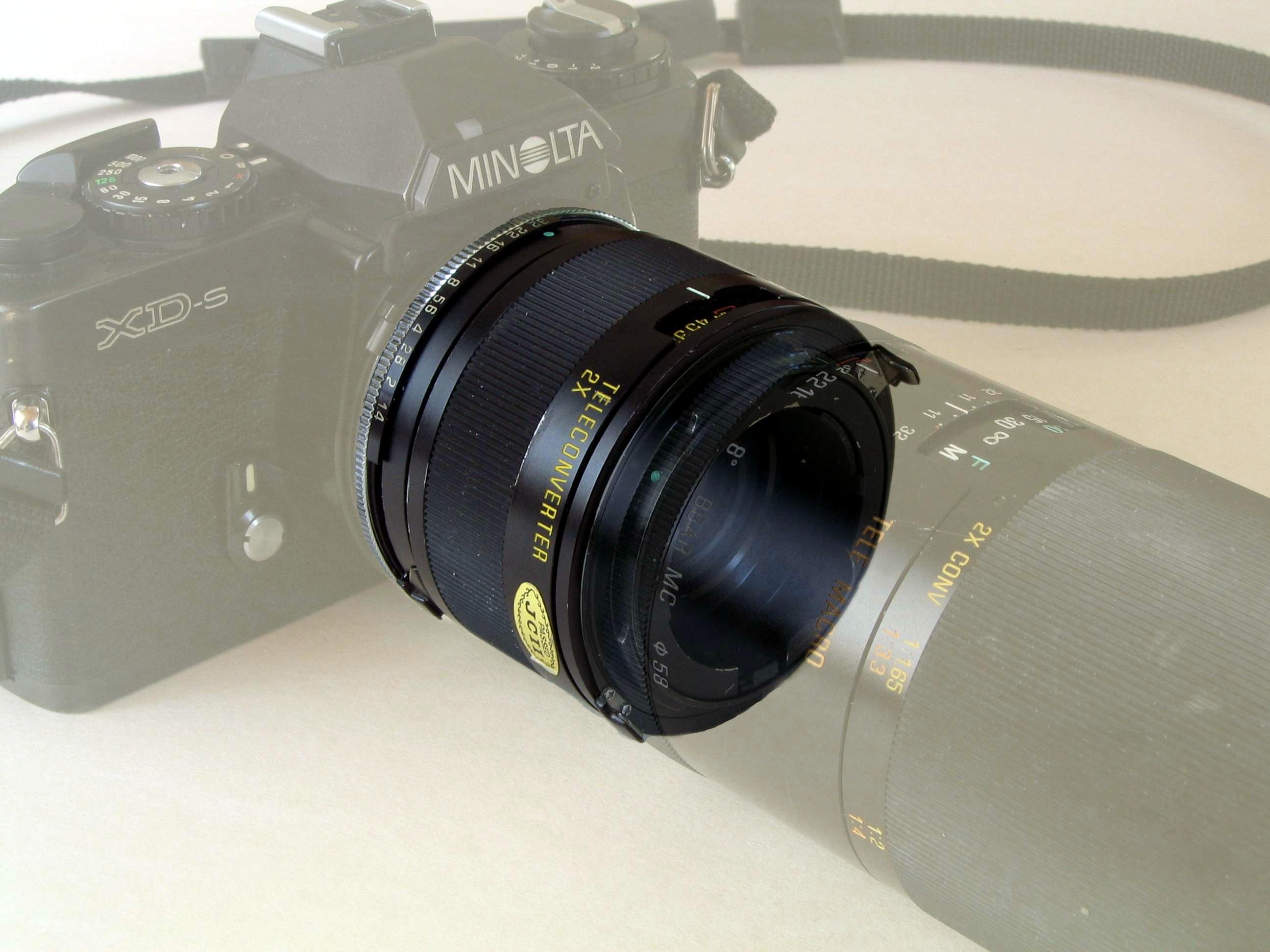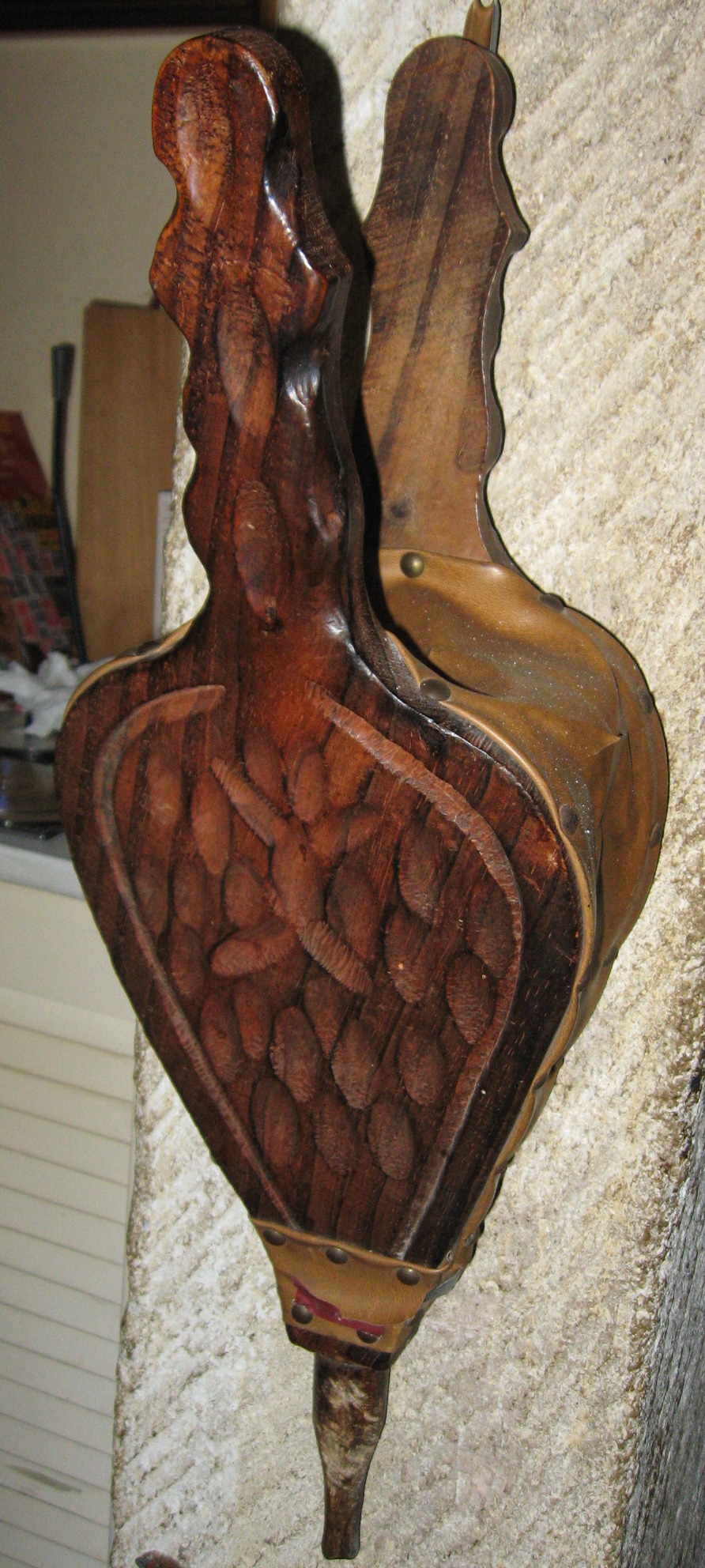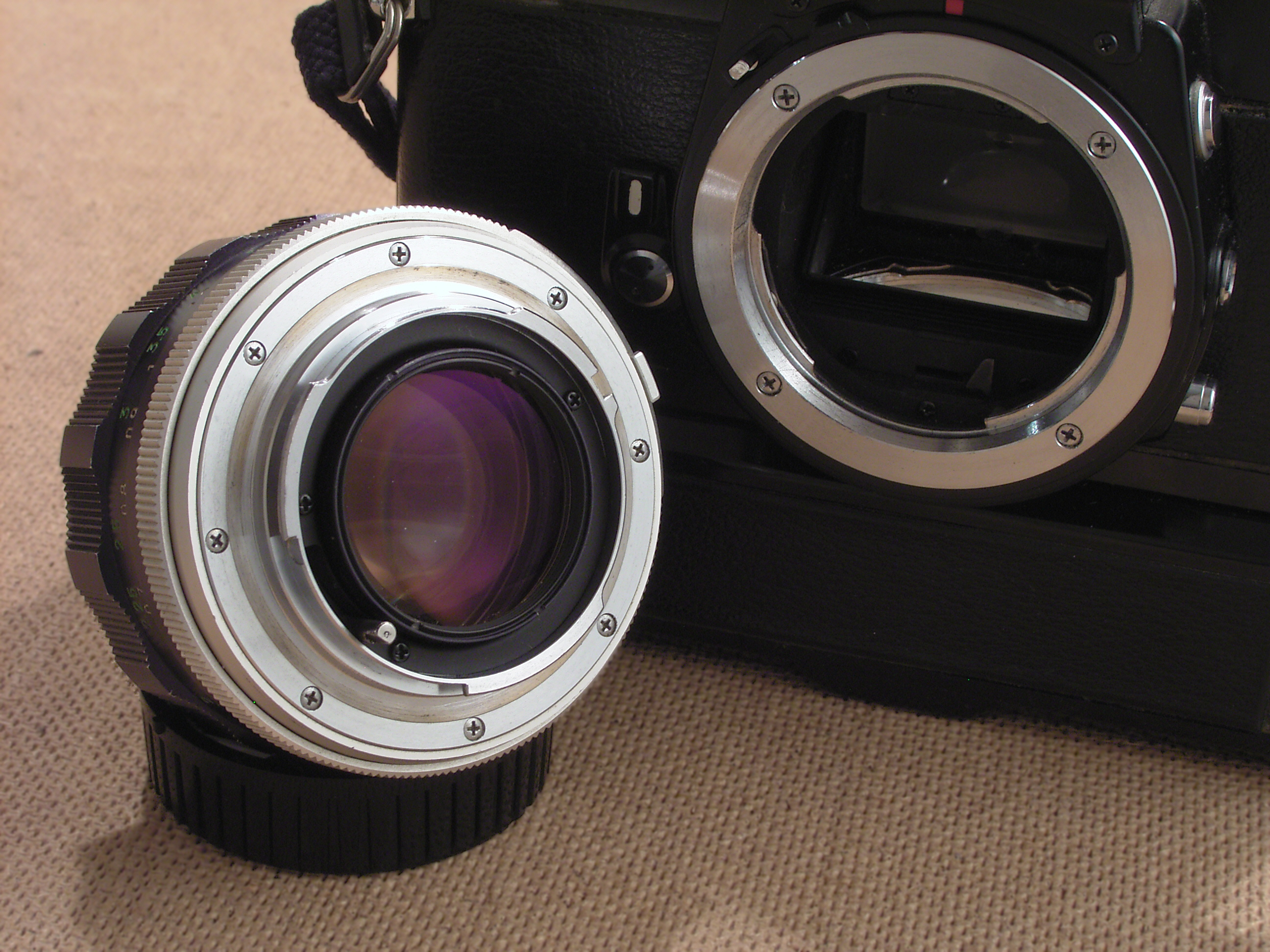|
Extension Tube
An extension tube, sometimes also called a closeup tube or an extension ring, is used with interchangeable lenses to increase magnification. This is most often used in macro photography. Construction The tube contains no optical elements; its sole purpose is to move the lens further from the image plane. The further away the lens is, the closer the focus, the greater the magnification, and also the greater the loss of light (requiring a longer exposure time). Lenses classically focus closer than infinity by moving all optical elements further from the film or sensor; an extension tube simply enables this movement. Since extension tubes do not have optics, they do not affect the optical quality of a lens. Due to their function, there are other effects: decrease of light; shallower depth of field; and loss of ability to focus at infinity. The longer the extension tube, the closer the lens can focus. Correspondingly, the amount of light and depth of field will be reduced. On ... [...More Info...] [...Related Items...] OR: [Wikipedia] [Google] [Baidu] |
F-number
An f-number is a measure of the light-gathering ability of an optical system such as a camera lens. It is calculated by dividing the system's focal length by the diameter of the entrance pupil ("clear aperture").Smith, Warren ''Modern Optical Engineering'', 4th Ed., 2007 McGraw-Hill Professional, p. 183. The f-number is also known as the focal ratio, f-ratio, or f-stop, and it is key in determining the depth of field, diffraction, and Exposure (photography), exposure of a photograph. The f-number is dimensionless number, dimensionless and is usually expressed using a lower-case Ƒ, hooked f with the format ''N'', where ''N'' is the f-number. The f-number is also known as the inverse relative aperture, because it is the Multiplicative inverse, inverse of the relative aperture, defined as the aperture diameter divided by focal length. The relative aperture indicates how much light can pass through the lens at a given focal length. A lower f-number means a larger relative apertur ... [...More Info...] [...Related Items...] OR: [Wikipedia] [Google] [Baidu] |
Bellows (photography)
In photography, a bellows is the accordion-like, pleated expandable part of a camera, usually a large or medium format camera, to allow the lens to be moved with respect to the focal plane for focusing. Bellows are also used on enlargers. The bellows provides a flexible, dark extension between the film plane and the lens. Classification Two kinds of bellows are commonly used on cameras; bag bellows are normally used with a lens of short focal length, and accordion bellows with a much longer range of extension. For large format cameras, “double extension” refers to bellows that extend to a length equal to about twice the focal length of a standard lens, e.g. 300 mm for the 4×5 inch format. “Triple extension” for the same format indicates bellows extension of 450 to 500 mm. Flexibility Bellows allow movements that can be used to correct distortion in a photograph and to avoid converging or diverging verticals. Use of a bellows-based camera can ensure that paralle ... [...More Info...] [...Related Items...] OR: [Wikipedia] [Google] [Baidu] |
Close-up Lens
In photography, a close-up lens (sometimes referred to as ''close-up filter'' or a ''macro filter'') is a simple secondary lens used to enable macro photography without requiring a specialised primary lens. They work like reading glasses, allowing a primary lens to focus more closely. Bringing the focus closer allows the photographer more possibilities. Close-up lenses typically mount on the filter thread of the primary lens, and are often manufactured and sold by suppliers of photographic filters. Nonetheless, they are lenses and not photographic filter, filters. Some manufacturers refer to their close-up lenses as ''diopters'', after the unit of measurement of their optical power. Close-up lenses do not affect exposure, unlike extension tubes, which also can be used for macro photography with a non-macro lens. Optical power Close-up lenses are often specified by their optical power in diopters, the reciprocal of the focal length in meters. For a close-up lens, the diopter v ... [...More Info...] [...Related Items...] OR: [Wikipedia] [Google] [Baidu] |
Teleconverter
A teleconverter (sometimes called tele extender) is a secondary lens mounted between a camera and a photographic lens which enlarges the central part of an image obtained by the lens. For example, a 2× teleconverter for a 35 mm camera, 35 mm camera enlarges the central 12×18 mm part of an image to the size of 24×36 mm in the standard 35 mm film format. Teleconverters are typically made in 1.4×, 1.7×, 2× and 3× variants, with 1.4× and 2× being the most common. A 2× teleconverter doubles the apparent focal length of a given lens. Teleconverters also decrease the intensity of the light that reaches the film plane (or sensor) by the square of its magnification. A 2× teleconverter reduces the light to 1/4, doubles the f number, focal ratio and halves the angular resolution, resolution of the master lens it is connected to. This, however, does not necessarily halve the resolution of the digital image. A closely related device reduces the focal length. I ... [...More Info...] [...Related Items...] OR: [Wikipedia] [Google] [Baidu] |
Flange Focal Distance
For an interchangeable lens camera, the flange focal distance (FFD) (also known as the flange-to-film distance, flange focal depth, flange back distance (FBD), flange focal length (FFL), back focus or register, depending on the usage and source) of a lens mount system is the distance from the mounting flange (the interlocking metal rings on the camera and the rear of the lens) to the film or image sensor plane. This value is different for different camera systems. The range of this distance, which will render an image clearly in focus within all focal lengths, is usually measured to a precision of hundredths of millimetres, and is not to be confused with depth of field. Lenses can be adapted from one mount (and respective FFD) to another. FFD determines whether infinity focus can be accomplished with a simple non-optical adapter. Optics to correct for distance introduce more cost and can lower image quality, so non-optical lens adapters are preferred. A simple non-optical adap ... [...More Info...] [...Related Items...] OR: [Wikipedia] [Google] [Baidu] |
Aperture
In optics, the aperture of an optical system (including a system consisting of a single lens) is the hole or opening that primarily limits light propagated through the system. More specifically, the entrance pupil as the front side image of the aperture and focal length of an optical system determine the cone angle of a bundle of rays that comes to a focus in the image plane. An optical system typically has many structures that limit ray bundles (ray bundles are also known as ''pencils'' of light). These structures may be the edge of a lens or mirror, or a ring or other fixture that holds an optical element in place or may be a special element such as a diaphragm placed in the optical path to limit the light admitted by the system. In general, these structures are called stops, and the aperture stop is the stop that primarily determines the cone of rays that an optical system accepts (see entrance pupil). As a result, it also determines the ray cone angle and brightne ... [...More Info...] [...Related Items...] OR: [Wikipedia] [Google] [Baidu] |
Autofocus
An autofocus (AF) optical system uses a sensor, a control system and a motor to focus on an automatically or manually selected point or area. An electronic rangefinder has a display instead of the motor; the adjustment of the optical system has to be done manually until indication. Autofocus methods are distinguished as active, passive or hybrid types. Autofocus systems rely on one or more sensors to determine correct focus. Some AF systems rely on a single sensor, while others use an array of sensors. Most modern SLR cameras use through-the-lens optical sensors, with a separate sensor array providing light metering, although the latter can be programmed to prioritize its metering to the same area as one or more of the AF sensors. Through-the-lens optical autofocusing is usually speedier and more precise than manual focus with an ordinary viewfinder, although more precise manual focus can be achieved with special accessories such as focusing magnifiers. Autofocus accur ... [...More Info...] [...Related Items...] OR: [Wikipedia] [Google] [Baidu] |
Bellows Factor
A bellows or pair of bellows is a device constructed to furnish a strong blast of air. The simplest type consists of a flexible bag comprising a pair of rigid boards with handles joined by flexible leather sides enclosing an approximately airtight cavity which can be expanded and contracted by operating the handles, and fitted with a valve allowing air to fill the cavity when expanded, and with a tube through which the air is forced out in a stream when the cavity is compressed. It has many applications, in particular blowing on a fire to supply it with air. The term "bellows" is used by extension for a flexible bag whose volume can be changed by compression or expansion, but not used to deliver air. For example, the light-tight (but not airtight) bag allowing the distance between the lens and film of a folding photographic camera to be varied is called a bellows. Etymology "Bellows" is only used in plural. The Old English name for "bellows" was , 'blast-bag', 'blowing-bag' ... [...More Info...] [...Related Items...] OR: [Wikipedia] [Google] [Baidu] |
Lens Mount
A lens mount is an interface – mechanical and often also electrical – between a photographic camera body and a lens. It is a feature of camera systems where the System camera, body allows interchangeable lenses, most usually the rangefinder camera, single lens reflex type, single lens mirrorless type or any movie camera of 16 mm or higher film gauge, gauge. Lens mounts are also used to connect optical components in instrumentation that may not involve a camera, such as the modular components used in optical laboratory prototyping which join via C mount, C-mount or T-mount elements. Mount types A lens mount may be a screw-threaded type, a Bayonet#Linguistic impact, bayonet-type, or a breech-lock (friction lock) type. Modern still camera lens mounts are of the bayonet type, because the bayonet mechanism precisely aligns mechanical and electrical features between lens and body. Screw-threaded mounts are fragile and do not align the lens in a reliable rotational position, yet ... [...More Info...] [...Related Items...] OR: [Wikipedia] [Google] [Baidu] |
Exposure (photography)
In photography, exposure is the amount of light per unit area reaching a frame (photography), frame of photographic film or the surface of an electronic image sensor. It is determined by shutter speed, lens f-number, and scene luminance. Exposure is measured in unit of measurement, units of lux-seconds (symbol lxs), and can be computed from exposure value (EV) and scene luminance in a specified region. An "exposure" is a single shutter cycle. For example, a long-exposure photography, long exposure refers to a single, long shutter cycle to gather enough dim light, whereas a multiple exposure involves a series of shutter cycles, effectively layering a series of photographs in one image. The accumulated ''photometric exposure'' (''H''v) is the same so long as the total exposure time is the same. Definitions Radiant exposure Radiant exposure of a ''surface'', denoted ''H''e ("e" for "energetic", to avoid confusion with Photometry (optics), photometric quantities) and measured in , i ... [...More Info...] [...Related Items...] OR: [Wikipedia] [Google] [Baidu] |
Focus (optics)
In geometrical optics, a focus, also called an image point, is a point where ray (optics), light rays originating from a point on the object vergence (optics), converge. Although the focus is conceptually a point, physically the focus has a spatial extent, called the circle of confusion, blur circle. This non-ideal focusing may be caused by optical aberration, aberrations of the imaging optics. Even in the absence of aberrations, the smallest possible blur circle is the Airy disc caused by diffraction from the optical system's aperture; diffraction is the ultimate limit to the light focusing ability of any optical system. Aberrations tend to worsen as the aperture diameter increases, while the Airy circle is smallest for large apertures. An image, or image point or region, is in focus if light from object points is converged almost as much as possible in the image, and defocus aberration, out of focus if light is not well converged. The border between these is sometimes define ... [...More Info...] [...Related Items...] OR: [Wikipedia] [Google] [Baidu] |




